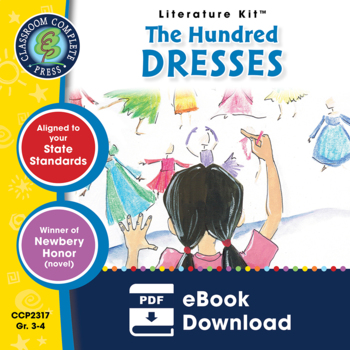The Hundred Dresses - Literature Kit Gr. 3-4
- PDF
What educators are saying
Description
A Literature Kit for the novel The Hundred Dresses written by Eleanor Estes.
Take a Peek Inside:
Bring to light the hardships of bullying. Offer a unique viewpoint on the hardships, perseverance and acceptance experienced by a young girl. Bring to the forefront topics for discussion about treating each other in a kindly manner. Students share their impressions of people based on where they live and how they dress to get them into the right mindset prior to reading the story. Find details in the story that set a serious tone when Miss Mason reads the note from Wanda's father. Use context clues to write the meanings of the underlined vocabulary words from the book. Predict how Wanda might react to Peggy and Maddie's visit after she moved. Recreate a scene from the novel into a play, and present it to the class.
About the Novel:
The Hundred Dresses is a Newbery Honor winning story about a young girl who is teased and mocked by her classmates. Wanda Petronski is different from the rest of the children in her class. She is poor and friendless, and is seated in the worse seat in the classroom. Constantly teased and mocked by her classmates for wearing the same faded blue dress every day, Wanda claims to own 100 dresses. This obvious lie causes her peers to mock her even more, resulting in her father's decision to move her to a different school. Before she leaves, she enters a drawing contest where she designs 100 different dresses. She moves away before realizing she has won the contest and the respect of her classmates.
Aligned to your State Standards and written to Bloom's Taxonomy, additional crossword, word search, comprehension quiz and answer key are also included.
************************************************************************
View Similar Titles:
► Matilda - Literature Kit Gr. 3-4
► Ramona Quimby, Age 8 - Literature Kit Gr. 3-4
► Frindle - Literature Kit Gr. 3-4
************************************************************************
Aligned to Common Core
RL.3.1, RL.3.2, RL.3.3, RL.3.4, RL.3.5, RL.3.6, RL.3.7, RL.3.10, RL.4.1, RL.4.2, RL.4.3, RL.4.4, RL.4.6, RL.4.10, RF.3.3, RF.3.4, RF.4.3, RF.4.4, W.3.1, W.3.2, W.3.3, W.3.4, W.3.7, W.3.8, W.4.1, W.4.3, W.4.4, W.4.7, W.4.8, W.4.9
************************************************************************
Check out our sister TPT shops:





